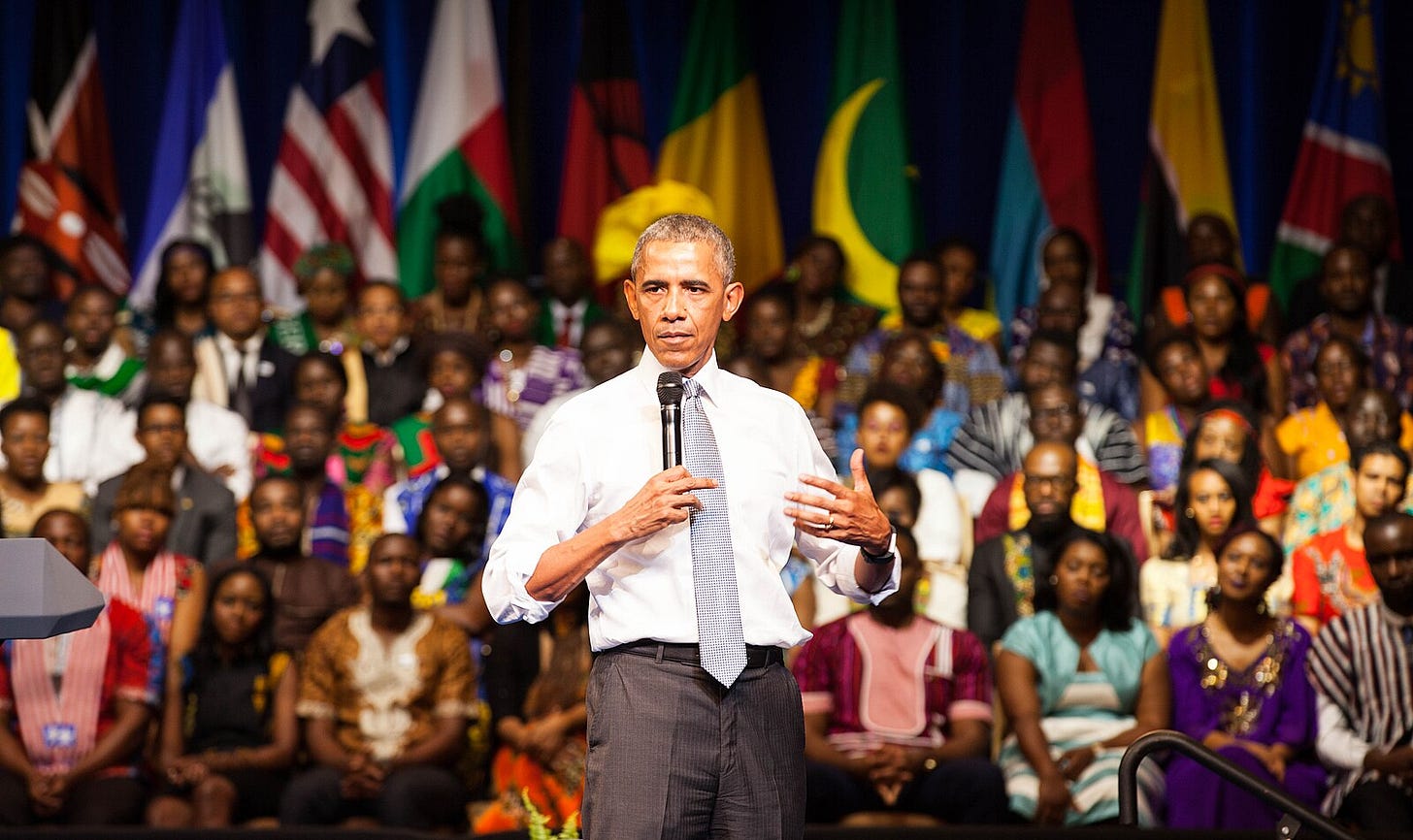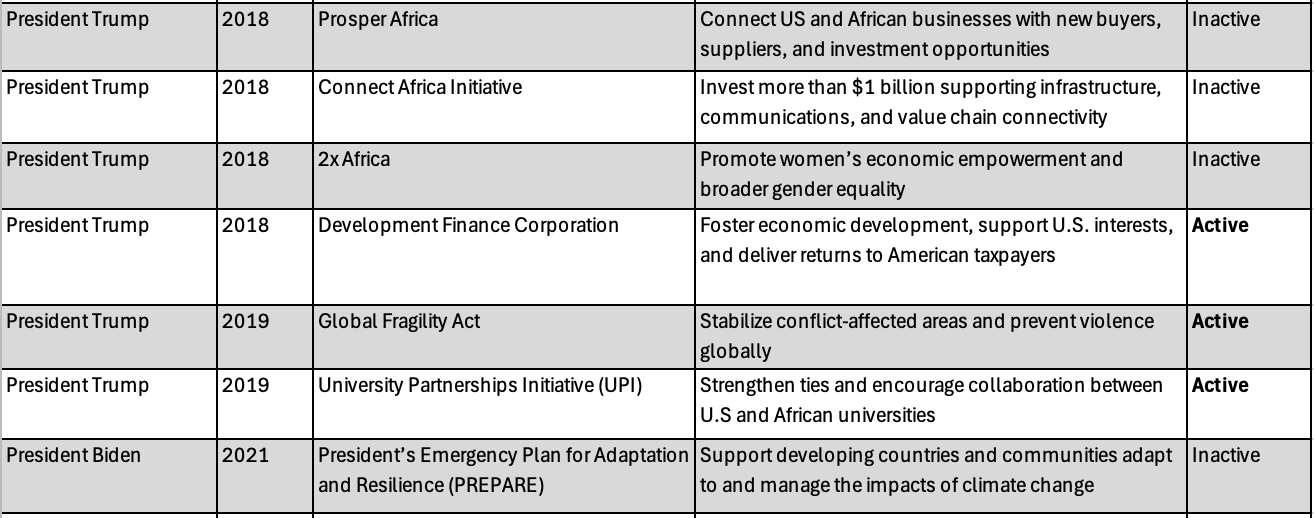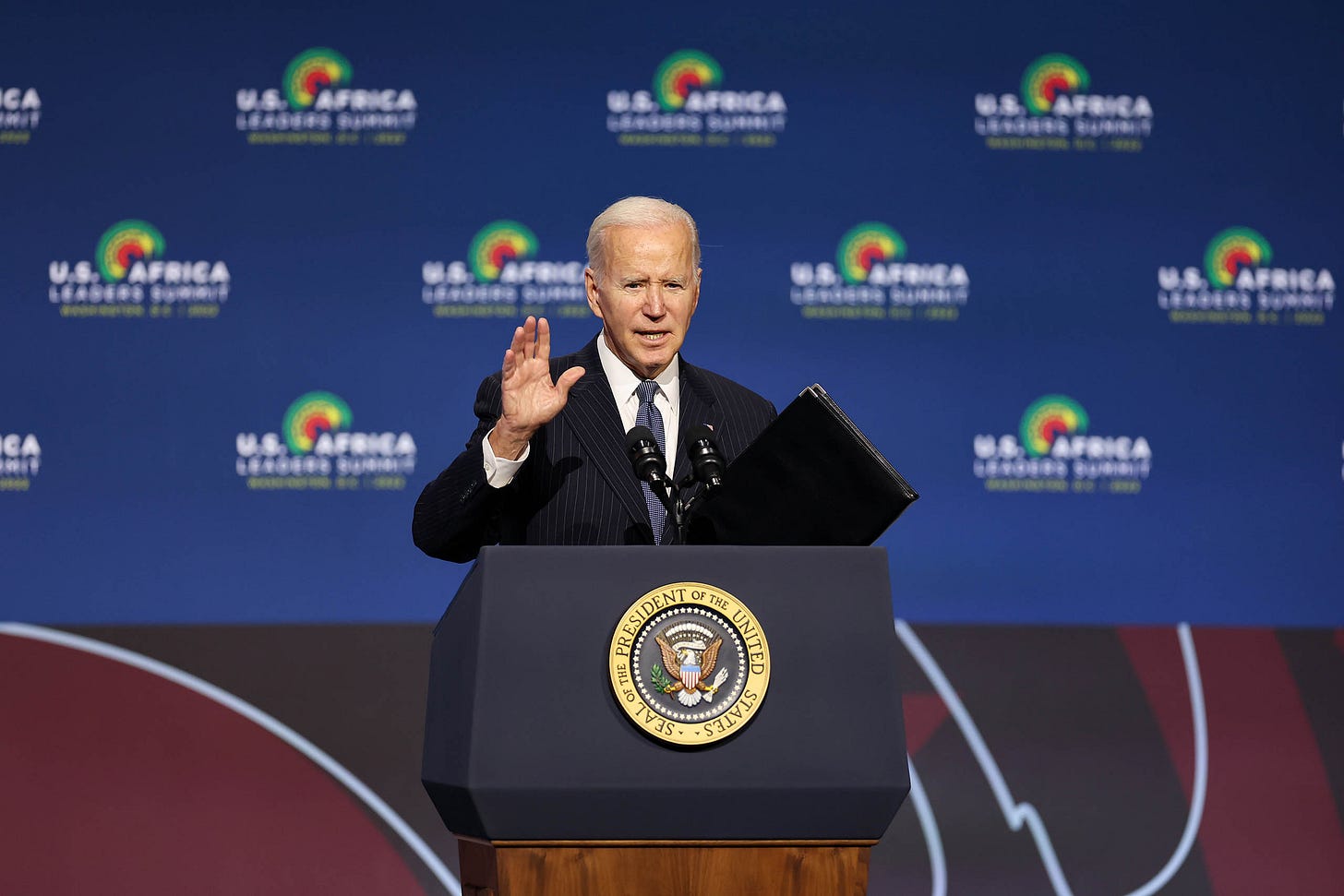On Initiatives
There have been more than 60 U.S. initiatives on Africa since the 1990s. Few have survived.
Since the end of Cold War, every U.S. Administration has trumpeted new policy initiatives toward Africa. It has become the primary mechanism for a U.S. president to demonstrate his commitment to the continent, as well as distinguish himself from his predecessors. It is both stagecraft and statecraft — showcasing a president’s priorities and shaping his legacy in Africa. And yet, the vast majority of these initiatives have faltered or have been forgotten.

A Graveyard of Initiatives
During my long career as an intelligence officer, think tank expert, and NSC Senior Director, I would routinely recite the shortlist of hugely successful, bipartisan U.S. initiatives on Africa. They numbered less than ten:
The African Growth and Opportunity Act (AGOA);
The President’s Emergency Plan for AIDS Relief (PEPFAR);
Millennium Challenge Corporation (MCC);
Young African Leaders Initiative (YALI);
Power Africa;
Development Finance Corporation (DFC); and
The Lobito Trans-Africa Corridor — as part of the Partnership for Global Infrastructure and Investment (PGI).
However, I was stunned when I discovered that the U.S. government has launched more than 60 initiatives on Africa (or at least ones with a significant focus on the region) since the early 1990s. Many of these efforts never amounted to much, debuting on a factsheet and then quickly disappearing from view. Others started strong, but they soon lost momentum, eventually incorporated into existing programs or terminated after a few years. By my count, only 20 of these initiatives remain active.

The Tyranny of Deliverables
Here’s the question: if these initiatives are central to an administration’s Africa policy, why have they proven to be so ephemeral and forgettable?
The first part of the answer requires understanding why they were launched in the first place. Many of these initiatives were rushed to meet the requirements of a presidential trip, summit, or state visit. That’s why new initiatives sprout up in bunches:
President Clinton used his trip to Ghana, Uganda, Botswana, and Senegal in March 1998 to introduce new programs and tout his Administration’s efforts regarding development, trade, investment, empowerment of women, and the environment.
President Bush unveiled new initiatives during his trip to Senegal, South Africa, Botswana, Uganda, and Nigeria in July 2003. The White House subsequently posted a press release about his accomplishments and initiatives toward the region.
President Obama issued 14 factsheets to underscore his Administration’s efforts during the U.S.-Africa Leaders Summit in 2014. President Biden similarly released 14 statements, readouts, and factsheets during second U.S-Africa Leaders Summit in 2022. The White House also posted an update at the one-year anniversary of the summit and issued a second at the two-year mark.
The Tricks of the Bureaucracy
The second part of the answer is how these new initiatives were constructed. Due to time constraints, most new programs were stapled together hastily. They consequently suffered from a host of problems:
No Theory of the Case. Most initiatives lack a thoughtfulness about what they are trying to achieve. U.S. officials consequently lean on buzzwords, such as prosperity, growth, reform, integration, etc., to dress up new programs. In truth, many of the trade and investment programs have been almost carbon copies of each other. And, when under pressure to launch something big, the interagency often turns to the public-private partnership as a short-cut. During her trip to the region in 2023, for example, Vice President Harris issued a “Call to Action” to the private sector. It eventually evolved into the nonprofit Partnership for Digital Access in Africa (PDAA) a year later, but it has struggled to find its footing and make its mark as a signature initiative.
No Bureaucratic Buy-In. The imperative to generate new programs tends to lead to initiatives being shoved down the interagency’s throat — even if they are good ideas. When I was at the NSC, I wanted to establish a new security assistance program that included positive conditionality. It wasn’t a new concept; indeed, several scholars have argued for this approach for years. But, when we directed the Department of Defense officials to take on this initiative, they had a fit. Guess what happened? The 21st Century Partnership for African Security (21PAS) was never implemented in earnest.
No Consistent Funding. New initiatives are often announced outside of the regular budget cycle. Since they don’t have their own budget line item, the only option is to cobble together funding from other sources, either rebranding existing programs or redirecting money, which requires congressional notifications. (Side note: that’s why you always see the line “working with Congress” in factsheets and speeches.) If the program is an amalgam of existing efforts, it is at constant risk of being dismantled or unfunded. That’s what happened to the African Democratic and Political Transition (ADAPT), an initiative designed to incentivize military leaders to restore civilian rule. Immediately following President Trump’s election, the interagency decided to draw down ADAPT’s funding and essentially end the program.

The Potential of Small Bets
I don’t want to come off as cynical. We often need an action-forcing event to ring out new commitments from the interagency. And, even if these programs fail in the long run, they do result in temporary funding increases for the region, which is a positive outcome.
The dilemma I faced was how to meaningfully seize the opportunity of an upcoming visit or summit, and at least navigate some of these structural obstacles to introduce new programs of substance with staying power. When I was at the White House, I opted for small bets. In other words, I voted for churning out several small innovative programs to see which ones would take root. My decision was informed by my experience observing the Obama and Trump Administrations.
At the 2014 Summit, Obama unleashed a torrent of new programs — some successful, others unremarkable. (does anyone even remember Trade Africa?). By flooding the zone, however, the Obama team gave itself room to invest and develop a handful of initiatives that eventually made a lasting impact.
In contrast, Trump’s most prominent initiative was Prosper Africa. The program promised to “support U.S. investment across the continent, grow Africa’s middle class, and improve the overall business climate in the region.” But Prosper Africa failed to find its footing, requiring U.S. officials to repeatedly relaunch the initiative during the next six years until it was finally terminated this year.

The Test of Time
In retrospect, I don’t think the “small bets” approach was fundamentally better. I suspect that some of our programs would have continued if President Trump wasn’t elected, but that’s cold comfort. The goal, of course, is to develop initiatives that deliver value for many years and remain active regardless of presidential administration or political party.
It seems to me that there are a few lessons we can learn from the past three decades:
Build Slowly. It is more effective to develop a new initiative thoughtfully and methodically. Don’t wait for the next trip or summit — start on day one and collaborate with smart people inside and outside of government. For instance, in conceptualizing Power Africa, there were broad consultations with industry, think tanks, and other stakeholders, followed by an intensive policy process led by the NSC. (I sat in one such meeting when I was the Director for Nigeria and was astonished at the expertise we had developed on the energy sector in short order.)
Enlist POTUS. It is critical that the president is invested in the new initiative. It is not enough to have him announced it in a speech. Only the president’s commitment will unlock the resources and political capital necessary to drive a transformational program. President Bush made PEPFAR the centerpiece of his 2003 State of the Union. Indeed, he continues to advocate for its continuation. He published an op-ed in support of reauthorization during the Biden Administration and reportedly called Secretary of State Rubio earlier this year to stave off further cuts
Court Congress. The most enduring initiatives have congressional backing. Whether it is AGOA, PEPFAR, or the Electrify Africa Act for Power Africa, it secures future funding and allows others to claim a stake in the process. If Representatives Sarah Jacobs and Sydney Kamlager-Dove had succeeded in passing their proposed legislation, I believe that the Africa Diaspora Council would have been protected from President Trump’s executive order that terminated the initiative.
Post-Strategy
I am convinced that signature initiatives are important, and they can deliver mutual benefit to the Americans and Africans. We should continue to innovate and implement new approaches, but we need to be exacting in this effort. It is neither efficient nor effective to announce a bunch of new initiatives on every topic. The goal should be quality, not quantity. So, take a beat, think about where you want to go, and execute.










I see some similarities here with your first post on strategies. I noted then that you can’t be good at three things if you are focused on 30. This piece makes me think even more that simplicity and focus are recipes for success and endurance. Really informative piece.
What, Partnership for Atlantic Cooperation didn't make the list?!
In all seriousness, the lessons you end the piece with all seem reasonable to me, but they also seem procedural. Could it be that we need to learn some substantive lessons as well--like do our initiatives focus on the right things, at the right scale or level of complexity?
Another thought is that it would be interesting to see a deep dive comparison between some more successful vs. less successful initiatives. Is there systematicity to the differences that policymakers can learn from?